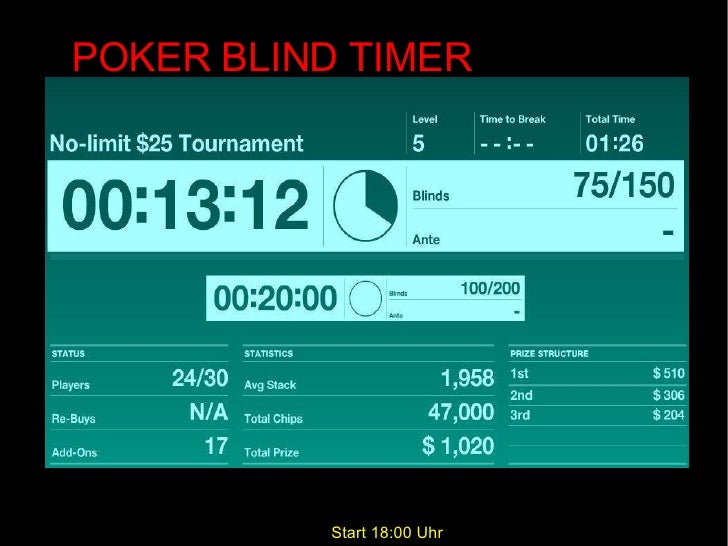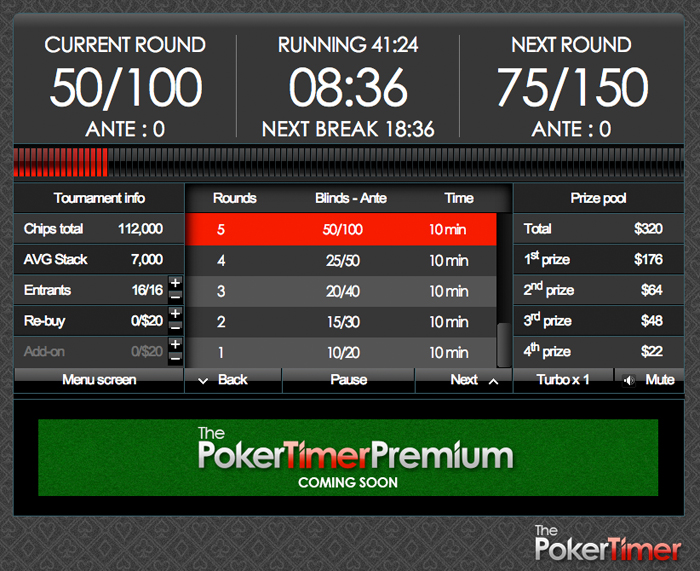Poker Blind Uhr
- Download this app from Microsoft Store for Windows 10, Windows 8.1. See screenshots, read the latest customer reviews, and compare ratings for Poker Blinds Timer.
- A simple online poker blind timer with options to configure blind levels and add breaks.
What are poker blinds ?
Based on the limit of the poker game the player to the left of the dealer’s button (small blind) and the player two to the left of the dealer (big blind) are required to place mandatory bets in the pot before cards are dealt (Small blind has to put half of the big blinds amount). These bets count toward the first round of betting. So if the pot is not raised pre-flop, small blind will only have to put half a bet to call and big blind has the option of raising or just checking.
A typical T10,000 blinds schedule for a No-limit Texas Hold'em poker tournament is shown to the right. T10,000 means that each player is issued 10,000 chips at the start of the tourney. This blinds schedule starts out slow for the first hour and should result in a poker tournament of about 4 hours. A feature rich and simple poker timer that helps you manage a Texas Holdem tournament of any size. The clock timer supports small and large screens (including portrait or landscape views) with an elegant and large display that allows anyone in the room to view. Customize the alert ringer or better yet, have talking poker timer say the blind schedule out loud (in multiple languages) for people. In online poker, blinds range from as little as one U.S. Cent to USD1,000 or more. The minimum and maximum buy-in at a table is usually set in relation to the big blind. At live games, the minimum buy-in is usually between 20 and 50 big blinds, while the maximum buy-in is usually between 100 and 250 big blinds.
In a poker tournament, blinds go up gradually. This is to ensure that the tournament finishes on a timely manner. (the higher the blinds get the more players tend to get eliminated).
Blinds usually go up after predetermined periods of time. (for example every 15 or 20 minutes).
Two main factors determine blind structure of the game:



- Starting chip amount
- How long you want the tournament to last.
Poker Blind Structure Tips
- The first big blind should be 1/50 of the starting chip amount. (or the starting chip amount should be 50 times the starting big blind). So if everyone starts with 1000 in chips the first big blind should be 10/20.
- Blind period is the time each blind lasts:
- Typical tournament blind periods are 10, 15, 20, 30, or 60 minutes.
- Blinds period should be the same for every blind.
- The faster the blind period is the faster the tournament ends and the more luck involves. So it’s a good idea to have slightly longer blind periods at your house game. 15 or 20 minute blind periods are good choices. Blinds in online websites tend to go up faster. This is because online poker action is much faster than live poker.
- Blinds typically double after each round. If the first big blind is 10/20, the next one should be 20/40.
Calculate Blind Structure

Poker Blind Timer
Follow these simple steps to create blind structure that best fits your game:
- Decide your starting chip amount.
- Divide it by 50. This should be your first big blind.
- Make your final big blind (when the tournament should finish) equal to your starting chip amount.
- Arrange the middle level blinds so that they gradually increase from your first big blind to the last one. It is best to keep the first couple blind periods low.
- Add the period (times) together. If it seems too long takes couple levels off the chart, and if it seems short add couple level to the chart.
Sample Tournament Blind Structure Chart

Poker Blinds Are Up
Following is a chart of recommended blind structures based on different starting chip stacks :
Poker Blind Timer App Android
| Blind Period | Chip Stack | |||
| 100 | 1000 | 2500 | 5000 | |
| 1 | 1/2 | 10/20 | 25/50 | 50/100 |
| 2 | 2/4 | 20/40 | 50/100 | 100/200 |
| 3 | 3/6 | 30/60 | 75/150 | 150/300 |
| 4 | 5/10 | 50/100 | 100/200 | 200/400 |
| 5 | 10/20 | 75/150 | 200/400 | 300/600 |
| 6 | 15/30 | 100/200 | 300/600 | 500/1000 |
| 7 | 25/50 | 150/300 | 500/1000 | 750/1500 |
| 8 | 50/100 | 200/400 | 750/1500 | 1000/2000 |
| 9 | 75/150 | 300/600 | 1000/2000 | 1500/3000 |
| 10 | 100/200 | 400/800 | 1500/3000 | 2000/4000 |
| 11 | 150/300 | 500/1000 | 2000/4000 | 3000/6000 |
| 12 | 200/400 | 1000/2000 | 2500/5000 | 5000/10000 |